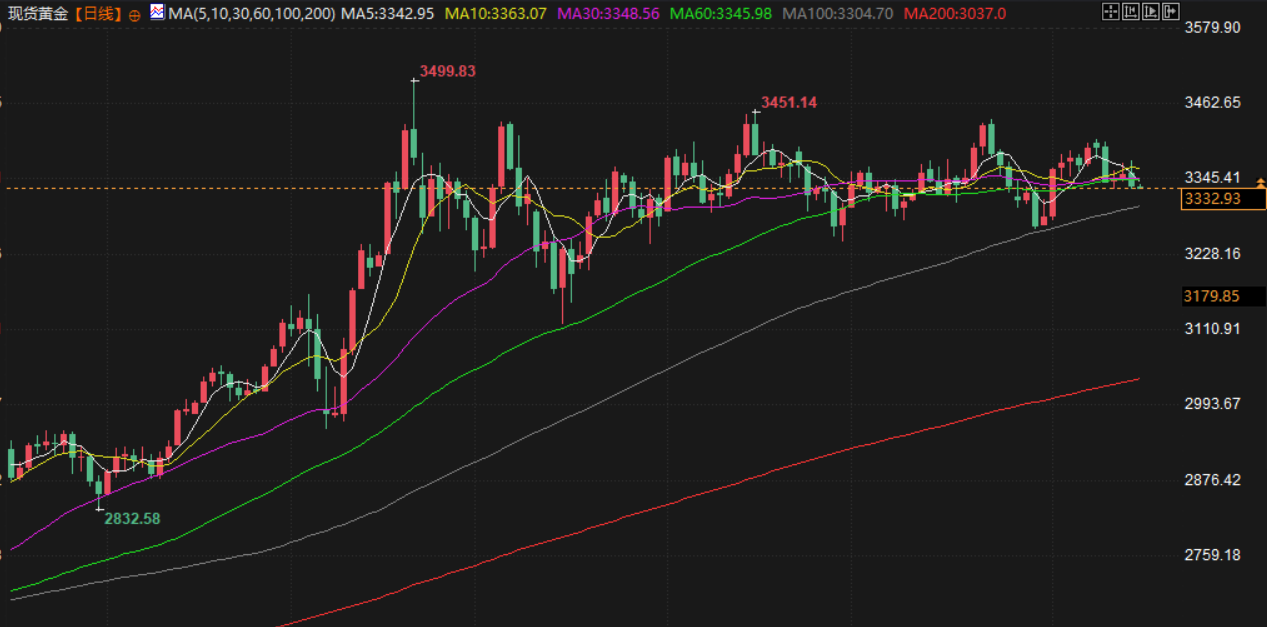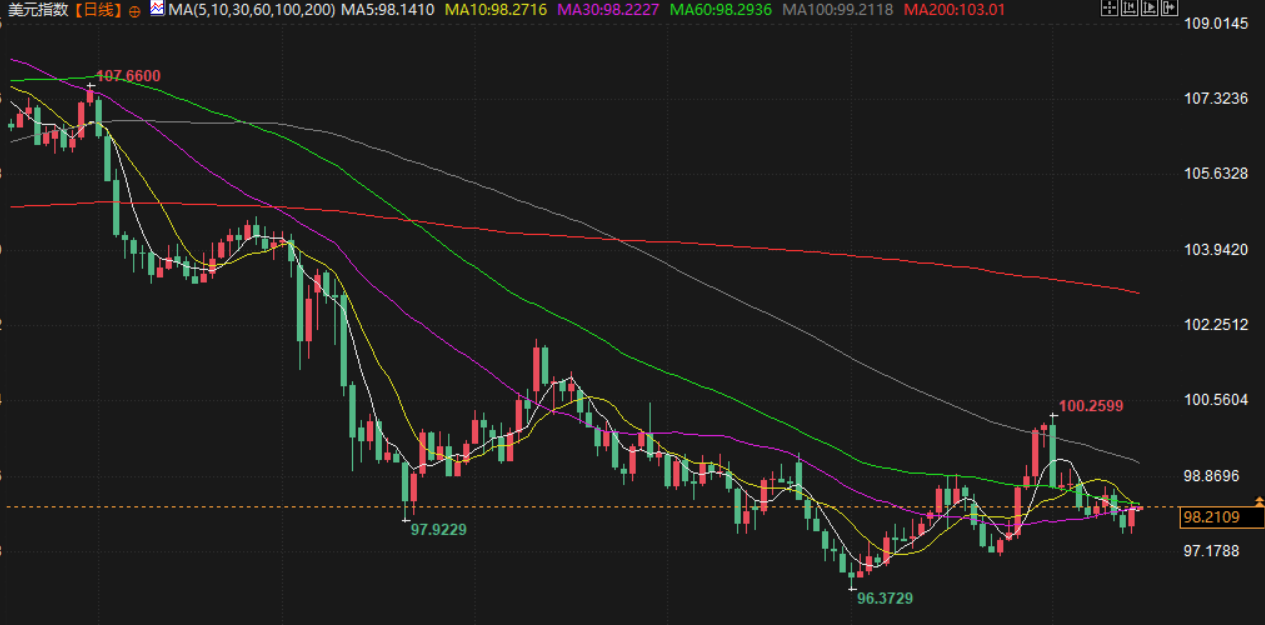August 15th Financial Breakfast: The Fed's September super-large rate cut bets are reduced, gold prices are stable around 3330, the countdown to the "Trump-Putin meeting" is underway, and oil prices hit a one-week high.
2025-08-15 07:19:57

Focus on the day

stock market
Wall Street's major indices were mixed on Thursday, with the S&P 500 rising to a closing high and the Dow and Nasdaq flat, after a stronger-than-expected producer price report dampened expectations of an interest rate cut.
The U.S. Labor Department reported that producer prices increased by the most in three years in July as the cost of goods and services surged, suggesting a broad-based pickup in inflation is imminent.
Traders lowered their expectations for Fed rate cuts in the second half of this year to around 56.7 basis points, from around 63 basis points before the report, according to data compiled by the London Stock Exchange Group (LSEG).
But they still fully priced in a quarter-point rate cut from the Federal Reserve in September.
Thierry Wizman, global foreign exchange and interest rate strategist at Macquarie Group, said: "This means that the Fed will cut interest rates by 25 basis points in September. But this will be a hawkish rate cut and the Fed wants to guide the market towards a continued easing cycle, but it is too early to tell. The next important event will be the spending price index later this month. If there are signs of broad inflation in the services sector, the market will be adversely affected by this." Another report on Thursday showed that the number of Americans applying for new unemployment benefits fell last week.
The Dow Jones Industrial Average closed down 0.02% at 44,911.26, the S&P 500 rose 0.03% to 6,468.54, a new closing high, and the Nasdaq fell 0.01% to 21,710.67. Seven of the 11 sectors in the S&P 500 fell on Thursday.
Recent data showing labor market weakness and modest consumer price increases have bolstered expectations that the Federal Reserve may cut interest rates next month. However, Thursday's report heightened concerns that U.S. tariffs on imports could begin to affect prices in the coming months and curb a rally in U.S. stocks that has helped the benchmark S&P 500 and the tech-heavy Nasdaq reach record highs over the past two sessions.
"Valuations are high in the U.S. stock market," said Sam Stovall, chief investment strategist at CFRA Research. He said the S&P 500's price-to-earnings ratio, based on forward estimates, is 23, nearly 40% above its 20-year average.
He added: "The PPI report was hotter than expected and now investors are saying 'They (the Fed) are going to cut rates, they're not going to cut rates.'"
St. Louis Fed President Moussallem, a voting member of this year's Federal Open Market Committee, said a 50 basis point rate cut was unnecessary a day after Treasury Secretary Jeff Bessant said a 50 basis point cut was possible at the Fed's September meeting.
Intel shares rose 7.4% after Bloomberg News reported on Thursday, citing people familiar with the matter, that the Trump administration is in talks with Intel about potentially taking a stake in the chipmaker.
Cisco Systems fell 1.6% after the networking equipment maker's earnings forecast was largely in line with expectations, but this did little to encourage investors.
Deere & Co. shares fell 6.8% after the farm equipment maker reported a decline in quarterly profit and tightened its full-year profit forecast, while Tapestry shares plummeted 15.7% after the Coach handbag maker reported a full-year profit that fell short of expectations. Both companies warned that tariffs would impact their businesses.
On the geopolitical front, focus will be on U.S. President Trump's upcoming meeting with Russian President Vladimir Putin as he seeks to put a stop to the conflict in Ukraine.
Gold Market
Gold prices fell on Thursday as hotter-than-expected U.S. inflation data and a drop in jobless claims boosted the dollar and Treasury yields, reducing the likelihood of a super-large interest rate cut in September.

Spot gold fell 0.5% to $3,337.21 an ounce. U.S. gold futures for December delivery settled down 0.7% at $3,383.2. The dollar index rose 0.5% from its lowest point in more than two weeks, while the benchmark 10-year yield rose from its lowest point in a week.
Stronger U.S. wholesale price data tempered bets on a larger 50 basis point rate cut next month. The Labor Department reported that its producer price index rose 3.3% year-on-year in July, beating expectations for a 2.5% increase, while jobless claims fell short of expectations at 224,000 last week, compared to expectations for 228,000.
Ole Hansen, head of commodity strategy at Saxo Bank, said: "The hotter-than-expected U.S. PPI data may reduce expectations for rate cuts as it will also lead to a rise in the core PCE inflation data for July, which may make the Fed cautious about cutting interest rates. Overall, the data does not change our bullish view on gold as the Fed will eventually have to choose between fighting inflation or supporting the economy."
Traders are now favoring a 25 basis point rate cut next month and another 25 basis point reduction in October, reinforcing Fed Chair Daly's view against the need for a 50 basis point rate cut in September.
Elsewhere, spot silver fell 1.3% to $37.97 an ounce, platinum rose 1.1% to $1,354.33, and palladium rose 2% to $1,144.5.
Oil Market
Oil prices rose about 2% on Thursday to a one-week high after U.S. President Donald Trump warned of "serious consequences" if talks with Russian President Vladimir Putin over Ukraine failed and amid optimism that a U.S. interest rate cut next month would boost oil demand.

Central banks like the Federal Reserve use interest rates to control inflation. Lower interest rates make borrowing less expensive for consumers, boosting economic growth and oil demand.
Brent crude futures settled up 1.8% at $66.84 a barrel, while U.S. crude futures rose 2.1% to $63.96. The price gains lifted both crude benchmarks out of technically oversold territory for the first time in three days and pushed Brent to its highest close since August 6.
On Tuesday, Brent crude settled at its lowest level since June 5 and U.S. crude settled at its lowest level since June 2, partly due to bearish inventory and supply data from the U.S. Energy Information Administration (EIA) and the International Energy Agency (IEA).
U.S. President Trump said on the eve of his summit with Russian President Vladimir Putin on Friday that he believed Putin was ready to reach a deal to end the war in Ukraine.
But on Wednesday, Trump threatened Putin with "serious consequences" if he did not agree to peace in Ukraine, without elaborating. Trump also warned of economic sanctions if Friday's talks failed to produce results.
Russia was the second-largest crude oil producer after the United States in 2024, so any agreement that could ease sanctions on Moscow could increase the amount of Russian oil available for export to global markets. Trump has threatened to impose secondary tariffs on buyers of Russian crude oil if Russia continues its war in Ukraine.
“Uncertainty surrounding US-Russia peace talks continues to add to the bullish risk premium, given the potential for greater economic pressure on Russian oil buyers,” Rystad Energy said in a client note.
However, some analysts remain skeptical that Trump will take actions that could seriously disrupt oil supplies.
Oil prices were also supported by expectations of a September interest rate cut by the Federal Reserve, which traders largely believe will happen next month after a modest rise in U.S. consumer prices in July.
But a bigger-than-expected rise in wholesale prices is likely to heighten concerns among Federal Reserve policymakers that rising inflation still poses a risk, exacerbating the debate over whether to cut interest rates next month and leaving tensions between the Fed and the White House unresolved.
foreign exchange market
The dollar rose broadly on Thursday after data showed U.S. producer prices rose more than expected in July as prices of services and goods surged, suggesting a broad-based rise in inflation in the coming months.

Better-than-expected consumer price inflation for July, released on Tuesday, prompted traders to increase bets that the Federal Reserve will cut interest rates in the coming months.
While Thursday’s data did not shake the case for a September rate cut, it did raise concerns that tariffs could still spur inflation in the coming months and change the course of rate cuts for the rest of the year.
The data also dampened the chances of the Federal Reserve cutting interest rates by 50 basis points in September, a move Treasury Secretary Jeff Bessant had hinted at in an interview on Wednesday.
"I never thought that was likely, but I think this PPI report will dispel that notion," said Matt Weller, director of global market research at StoneX.
St. Louis Federal Reserve Bank President Mousallem said on Thursday that a half-percentage point rate cut at the Fed's September meeting was unnecessary given current economic conditions, with the United States close to full employment, inflation above the 2% target, and businesses still in the early stages of adjusting to increased tariffs.
StoneX's Weller said the inflation data does raise questions about whether the Federal Reserve will be able to cut interest rates significantly over the rest of the year.
“Some are saying we might see three consecutive rate cuts of 25 basis points each, but if we’re anywhere near this level of inflation, it seems we might see two cuts at most, and even that might be in doubt,” Weller said.
Data from the London Stock Exchange Group (LSEG) showed that traders still believe a Fed rate cut on September 17 is almost certain.
The dollar index rose 0.5% to 98.25. The euro fell 0.5% against the dollar to $1.16413, while the pound fell 0.3% against the dollar to $1.35325. However, analysts warned not to expect a sustained rebound in the dollar.
"The market is likely to remain 'fully priced' in on a September rate cut, at least until we hear Powell speak at Jackson Hole next week," said Michael Brown, market analyst at London-based online broker Pepperstone.
The dollar rose 0.3% against the yen to 147.87 yen, having earlier fallen after Bensoner suggested the Bank of Japan needed to raise interest rates again soon.
While upbeat Australian jobs data eased concerns about a weakening labor market and reduced the need for another interest rate cut in the near term, a stronger dollar still weighed on the Australian dollar. The Australian dollar fell 0.8% to $0.6495 against the greenback in late New York trading.
International News
Russian President's Press Secretary: No document will be signed after the meeting between Russian and US presidents
Russian presidential press secretary Peskov said on the 14th that Russia and the United States have no plans to sign any documents after the presidential meeting, and the leaders of the two countries will report the results of the meeting at a press conference.
Bensont denies pushing for a rate cut, citing models showing a 150 basis point cut is needed to reach neutral.
U.S. Treasury Secretary Jeff Bessant said he was not calling for a series of rate cuts from the Federal Reserve, but rather pointed out that models suggest the "neutral" rate is about 1.5 percentage points below current levels. "I'm not telling the Fed what to do," Bessant said in an interview Thursday, referring to his comments the day before that the Fed "could enter a series of rate cuts from now on." "What I'm saying is that to get to the neutral rate, it would take about 150 basis points of rate cuts," Bessant said Thursday.
Trump reveals more details of the meeting as the countdown continues
On the 14th local time, US President Trump provided further details about his meeting with Russian President Vladimir Putin. Speaking about the meeting in a Fox News interview, Trump stated that he believed Putin would reach an agreement. He also estimated the risk of failure at "25%." Trump also stated that the meeting on the 15th would lay the groundwork for a second agreement, and that sanctions would be imposed if issues were not resolved. He stated that border and land issues would be a process of give-and-take. Trump did not elaborate on the terms "reaching an agreement," "second meeting," or "sanctions." He said he did not know whether the meeting would result in a consensus on an immediate ceasefire. If so, he would call Ukrainian President Volodymyr Zelensky and European leaders. Trump stated that a post-meeting press conference would be held regardless, but he did not know whether it would be a joint press conference.
The United States announced a temporary exemption of some sanctions against Russia
The US Treasury Department announced that it will temporarily waive some sanctions against Russia to allow transactions necessary for the US-Russia summit in Alaska. US President Trump will meet with Russian President Vladimir Putin in Anchorage, Alaska, on August 15th, with the focus on promoting a ceasefire in Ukraine. If progress is successful, further meetings with Ukrainian President Volodymyr Zelensky may be scheduled after the summit. According to the UK's Daily Telegraph, Trump plans to propose a package of economic incentives, including granting Russia access to some Alaskan natural resources, easing some sanctions on Russia's aviation industry, and allowing Russia to sell rare earth minerals mined in Ukrainian territory currently under Russian military control, in order to facilitate a ceasefire agreement between Russia and Ukraine.
U.S. Treasury Secretary Bensonte: Please pay attention to drug tariffs
U.S. Treasury Secretary Scott Bessant said the Trump administration expects to make "a lot of announcements related to the pharmaceutical industry." "Please watch this over the next few weeks," Bessant said. "I think you're going to see a surge in pharmaceutical factory construction in the United States."
Russia confirms that the "Putin-Trump meeting" will be held at the US military base in Alaska
Russian presidential aide Ushakov said on the 14th local time that the main part of the Russian-US leaders' meeting will be held at Joint Base Elmendorf-Richardson in Anchorage, Alaska. (CCTV News)
Domestic News
National Data Bureau: China's total computing power ranks second in the world, and problems such as "lack of core technology and lack of core soul" are gradually being resolved
At 10:00 a.m. on August 14, the State Council Information Office held a press conference on the achievements of Digital China during the 14th Five-Year Plan period. Liu Liehong, member of the Party Leadership Group of the National Development and Reform Commission and Director of the National Data Administration, stated that the industry often cited a "lack of core competence" in the past, vividly reflecting my country's inadequate self-reliance and control over high-end chips and operating systems. After years of sustained effort, breakthroughs have been made in a number of key core technologies in the digital sector, gradually resolving these challenges and demonstrating my country's remarkable development achievements. The deployment of integrated circuits is accelerating, forming a complete industrial chain encompassing design, manufacturing, packaging and testing, materials, and equipment. Domestic operating systems are rapidly gaining momentum. For example, the HarmonyOS ecosystem has surpassed 1.19 billion devices, equipping over 1,200 categories of products, including mobile phones, automobiles, and home appliances, with intelligent cores. my country's comprehensive AI capabilities have achieved a comprehensive and systematic leap forward, with AI patents accounting for 60% of the global total. Breakthroughs are also being made in areas such as humanoid robots and smart terminals.
The number of Internet users in my country has reached 1.123 billion, and the Internet penetration rate has reached 79.7%.
At a press conference held by the State Council Information Office on Thursday, officials from the National Data Administration stated that my country currently has 1.123 billion internet users, with an internet penetration rate of 79.7%. Digital services that are accessible, affordable, and effective are benefiting more people. According to officials from the National Data Administration, during the 14th Five-Year Plan period, internet hospitals nationwide will serve over 100 million people annually, the number of medical insurance code users nationwide will exceed 1.2 billion, and direct cross-provincial medical settlement will benefit 560 million people. my country has built the world's largest and most resource-rich national smart education platform. 1.07 billion people nationwide have received electronic social security cards, covering over 75% of the population. The National Elderly Care Service Information Platform has been launched, promoting the efficient connection between supply and demand of elderly care service resources.
- Risk Warning and Disclaimer
- The market involves risk, and trading may not be suitable for all investors. This article is for reference only and does not constitute personal investment advice, nor does it take into account certain users’ specific investment objectives, financial situation, or other needs. Any investment decisions made based on this information are at your own risk.





















